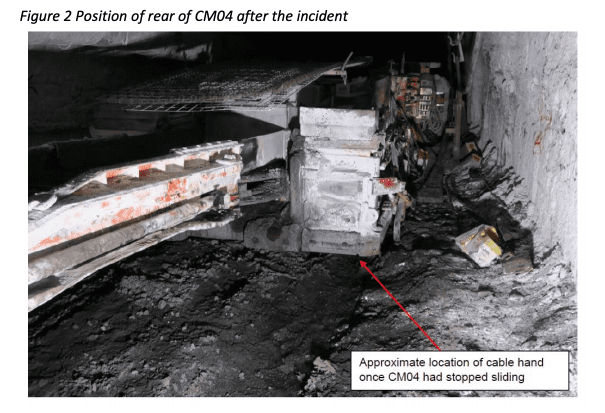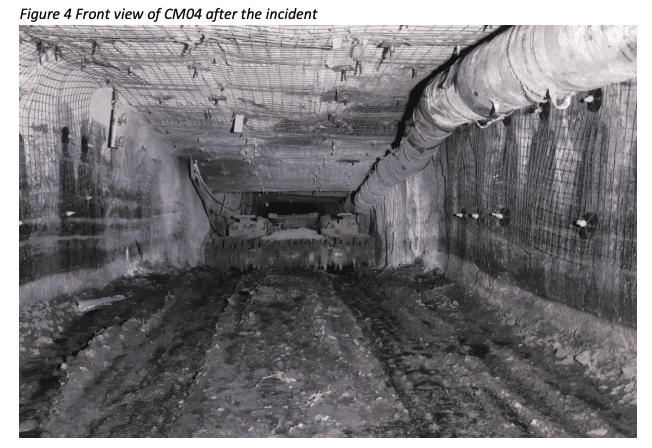NSW Resources Regulator has published an investigation report into a dangerous incident that occurred at Ashton Coal Mine, Camberwell.

On 30 May 2019, a dangerous incident involving an unplanned movement of a continuous miner occurred within an underground roadway at the Ashton Coal mine (the mine) located in Camberwell near Singleton NSW. Yancoal Mining Services Pty Ltd (mine operator) was the nominated mine operator for the mine having held the nomination since 31 March 2016.
Dangerous incident at underground mine
Major milestone reached in Pike River Re-entry
The roadway was under development and was designed to run approximately 205 metres in length with an average upward grade of 1:10. At the time of the incident, approximately 112 metres of the initial first pass mining of the road had been completed with an average overall uphill grade of 1:8. The roadway conditions were generally wet and slippery with varying uphill grades that were in some areas quite steep but did not exceed the continuous miner’s safe operating limits as stated by the original equipment manufacturer (OEM).
During afternoon shift, a deputy, continuous miner driver (CM driver) and a mining technician (cable hand) were operating a Joy 12CM12 continuous miner identified as CM04 to trim a small 10-15 metre section of roadway floor leading up to the face.
While attempting to tram forward and trim the floor, the continuous miner (CM04, miner) lost traction causing it to slide backwards down the sloped roadway. When CM04 first began to slide, the cable hand was standing approximately 10 to 15 metres behind it. The CM driver was operating remotely while positioned on CM04’s right-hand side operator platform with the shift deputy standing next to him.

Once the CM04 began to slide, the CM driver immediately attempted to apply the brakes using the remote, but it had no effect on stopping its movement. The CM driver and deputy then alerted the cable hand to get out of the way. The cable hand slipped and fell to the floor while attempting to turn and run clear of the path of the approaching continuous miner. The CM04 continued to slide down the road with its rear bumper contacting the cable hand before coming to rest after travelling approximately 10 to 15 metres. As a result of the incident, the cable hand suffered psychological trauma and sustained soft tissue injuries to the back of his shoulder, his hand, thumb, chest and legs.
Investigation findings
The investigation determined the following key findings:
- The section of underground roadway involved in the incident contained areas that were wet, slippery and steep in grade, however remained within the safe operating limits of the continuous miner as stated by the OEM.
- Testing of the continuous miner and its remote did not identify any functionality issues, mechanical, electrical or hydraulic faults attributable to the incident.
- The incident was most likely caused by the environmental conditions of the roadway including:
- steep longitudinal grade
- slippery floor conditions
- hard stone floor substrate.
- The mine operator had identified the general risk of workers being struck by a continuous miner during tramming but had not foreseen and considered the risk of a continuous miner losing traction and sliding down the steep grade of an underground roadway.
- To manage the risk of workers being struck by a continuous miner during tramming, the mine operator primarily relied on key controls which included:
- incorporating safety systems into the design of its 12CM12 continuous miners
- implementation of safe standing zones
- implementation of maximum grade limits for underground roadways
- trained and competent worker requirements.
- The safe standing zones implemented by the mine operator had not accounted for the possibility of a continuous miner losing traction and sliding backward in excess of the two metre control zone perimeter.
- The mine operator had implemented roadway design rules that prescribed a maximum 1:5 longitudinal grade limit, which provided a higher factor of safety compared to the OEM’s stated 1:3.5 safe operating limit for CM04.
- Deputies were required to inspect roadway conditions to ensure grade compliance, but some were unaware of the mine’s maximum road grade design rules.
- The section of underground roadway involved in the incident contained areas that were wet, slippery and steep in grade, however remained within the safe operating limits of the continuous miner as stated by the OEM.
Recommendations
It is recommended that mine operators:
- review operational risk assessments to ensure appropriate consideration is given to the risk of mobile plant slippage due to underground roadway conditions including:
- steep roadway grades
- slippery floor conditions
- hard stone floor substrates.
- review and risk assess the design and configuration of continuous miners operated on site, and where reasonably practicable, ensure they are fitted with appropriate equipment that allows workers to readily identify the pitch and roll positioning of the miner chassis
- review and update operating procedures to ensure safe standing and pedestrian access zone perimeters account for the possibility of a continuous miner losing traction and sliding down steep underground roadways
- ensure that underground roadways with steep grades (including those under development) are appropriately sign posted to alert workers of hazardous conditions and the potential for machine slippage
- ensure that all workers involved in the operation of continuous miners are provided:
- appropriate information, instruction and training in identifying hazardous roadway conditions that could increase the likelihood of machine slippage
- appropriate equipment, information and/or suitable means to readily identify the pitch and roll positioning of the miner chassis.
- ensure that all workers required to inspect underground roadway conditions are provided:
- appropriate information, instruction and training in the mine’s maximum road grade design rules
- appropriate equipment, information and/or suitable means to readily identify roadway grade compliance during inspections.
Read more Mining Safety News























